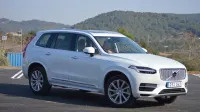Volvo’s latest powertrains show what the Swedish brand can do

This turbocharged and Eaton-supercharged four is mated to a new eight-speed automatic (another element of Volvo’s Drive-E efficiency system) and generates a healthy 316 horsepower and 295 lb-ft of torque. Yet its EPA economy ratings are 20 mpg city, 25 highway, and 22 combined, head-of-the-class for a gas-powered seven-seat luxury CUV. For comparison, the 2016 Mercedes-Benz GL-Class offers a 3.0-liter twin-turbocharged V-6 good for 362 horses but a thirstier 17 mpg city, 21 highway and 19 combined; the 2016 Infiniti QX60’s 3.5-liter V6 offers a comparable 19/26/22 mpg but just 265 hp; and Audi’s 2017 Q7 promises 333 horses and 19/25/21 mpg.

Volvo is transitioning virtually every vehicle it builds to its high-efficiency Drive-E engines based on the new Volvo Engine Architecture (VEA). This all-aluminum, all-turbocharged, direct-fuel-injected family will eventually include four 2.0-liter gasoline inline-fours, four 2.0-liter diesel four-cylinders, and a 1.5-liter gas three-cylinder, all sharing multiple common components and the same 0.5-liter cylinder displacement. The XC90’s twin-charged four is branded T6 because it replaces Volvo’s long-running T6 turbocharged inline-six, while the 240-hp turbocharged version that is superseding the old T5 turbocharged five-cylinder in other Volvo models keeps the T5 branding. So these new Drive-E engines (somewhat confusingly) wear the same old model designations, with the numbers now based on relative output and performance instead of cylinder count.
A team of Volvo engineers began planning an all-new engine family back in 2007, when the company was still owned by Ford and using derivations of Ford engines. Instead of continuing to invest time and money in adapting Ford engines to its vehicles, they determined that it would be better to design, develop, and manufacture their own. They built a solid business case explaining how doing so would benefit both companies, and when they learned that Ford was negotiating to sell Volvo to China’s Geely Automobile at the time, they presented and sold their VEA plan to Geely. The resulting Drive-E program also encompasses more-efficient drivetrains and build processes, and among its major objectives are manufacturing flexibility, exciting drivability, and best-in-class fuel economy.
“Achieving an effective level of balance across comfort, efficiency, and power has been the ultimate goal for our creation of the Drive-E engine family across our global model range,” says Volvo Car Group Powertrain vice president Michael Fleiss. “The T6 Drive-E’s use of both supercharging and turbocharging … delivers a lively, compelling result.”
All Volvo Drive-E engines feature continuously variable valve timing, “intelligent” heat management with an electric water pump, low-friction camshaft ball bearings, brake regeneration, and stop/start with an electric transmission oil pump that maintains pressure when the engine is off. And all are designed to be teamed with electrification in hybrid vehicles.

The first Drive-E hybrid is the just-arrived 2016 XC90 T8 Twin Engine plug-in. Starting at about $68K ($18K more than T6 models), it pairs the twin-charged 2.0-liter four with a 9.2-kWh lithium-ion battery and a 65-kW electric motor driving the rear wheels for 53-mpg EPA combined gas/electric AWD efficiency (25 mpg gas only). It’s capable of a claimed 5.7-second 0–60 run and a projected EV-only range of 24 miles. This system will also be offered (along with T5 turbo and T6 twin-charged Drive-E powertrains) in Volvo’s all-new 2017 S90 flagship sedan and the V90 wagon version.
Our experiences with all of Volvo’s new engines have been positive so far. Along with the renewed focus on style and craftsmanship, they show that Volvo has gotten over its post-Ford doldrums and is flourishing under Geely’s ownership. The Drive-E portfolio has us expecting continued innovation from the automaker in the future.
Related Video:
#fivemin-widget-blogsmith-image-708158{display:none;} .cke_show_borders #fivemin-widget-blogsmith-image-708158, #postcontentcontainer #fivemin-widget-blogsmith-image-708158{width:100%;display:block;}




